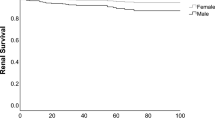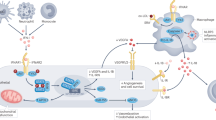Abstract
Systemic lupus erythematosus (SLE) is a multisystem autoimmune disease with a strong female predilection. Cardiovascular morbidity and mortality is a frequent complication, particularly in females aged 35–44 years, in whom the risk of myocardial infarction is raised 50-fold. The mechanisms underlying this increased risk are not fully understood. Certain traditional risk factors, such as hypertension and diabetes mellitus, are more common in SLE patients than in the general population. These factors do not, however, completely account for the increased cardiovascular risk; factors such as renal impairment, increased homocysteine levels and early menopause probably have a role. In addition, several factors more-specifically related to lupus are proposed to be of importance, including chronic inflammation, antiphospholipid antibodies and therapy, especially corticosteroid use. Thus, we need to be proactive in our approach to risk-factor management in SLE patients. Here, we propose that, like diabetes mellitus, SLE should be considered a coronary heart disease equivalent condition for baseline risk and that assessment of cardiovascular risk should be done routinely. In addition to lifestyle modifications, blood pressure and cholesterol levels should be stringently controlled, and administration of aspirin should be considered in selected patients. The increased use of certain interventions, such as statins, also needs to be more-widely investigated in this population.
This is a preview of subscription content, access via your institution
Access options
Subscribe to this journal
Receive 12 print issues and online access
$209.00 per year
only $17.42 per issue
Buy this article
- Purchase on Springer Link
- Instant access to full article PDF
Prices may be subject to local taxes which are calculated during checkout

Similar content being viewed by others
References
Johnson AE et al. (1995) The prevalence and incidence of systemic lupus erythematosus in Birmingham, England. Arthritis Rheum 38: 551–557
McCarty DJ et al. (1995) Incidence of systemic lupus erythematosus: race and gender differences. Arthritis Rheum 38: 1260–1270
Uromoto KM et al. (1999) Trends in the incidence and mortality of SLE, 1950–1992. Arthritis Rheum 42: 46–50
Abu-Shakra M et al. (1995) Mortality studies in SLE. Results from a single centre II: predictor variables for mortality. J Rheumatol 22: 1256–1270
Urowitz MB et al. (1976) The bimodal mortality pattern of systemic lupus erythematosus. Am J Med 60: 221–225
Ward MM (1999) Premature morbidity from cardiovascular and cerebrovascular diseases in women with systemic lupus erythematosus. Arthritis Rheum 42: 338–346
Manzi S et al. (1997) Age-specific incidence rates of myocardial infarction and angina in women with systemic lupus erythematosus: comparison with the Framingham Study. Am J Epidemiol 145: 408–415
Hosenpud JD et al. (1984) Myocardial perfusion abnormalities in asymptomatic patients with systemic lupus erythematosus. Am J Med 77: 286–292
Sella EM et al. (2003) Myocardial perfusion scintigraphy and coronary disease risk factors in systemic lupus erythematosus. Ann Rheum Dis 62: 1066–1070
Sella EM et al. (2003) Coronary artery angiography in systemic lupus erythematosus patients with abnormal myocardial perfusion scintigraphy. Arthritis Rheum 48: 3168–3175
Roman MJ et al. (2003) Prevalence and correlates of accelerated atherosclerosis in systemic lupus erythematosus. N Engl J Med 349: 2399–2406
Svenungsson E et al. (2001) Risk factors for cardiovascular disease in systemic lupus erythematosus. Circulation 104: 1887–1893
Doria A et al. (2003) Risk factors for subclinical atherosclerosis in a prospective cohort of patients with systemic lupus erythematosus. Ann Rheum Dis 62: 1071–1077
Leong KH et al. (1994) Lipid profiles in patients with systemic lupus erythematosus. J Rheumatol 21: 1264–1267
Petri M et al. (1992) Coronary artery disease risk factors in the Johns Hopkins Lupus Cohort: prevalence, recognition by patients, and preventive practices. Medicine (Baltimore) 71: 291–302
Bruce IN et al. (2003) Risk factors for coronary heart disease in women with systemic lupus erythematosus: the Toronto Risk Factor Study. Arthritis Rheum 48: 3159–3167
Esdaile JM et al. (2001) Traditional Framingham risk factors fail to fully account for accelerated atherosclerosis in systemic lupus erythematosus. Arthritis Rheum 44: 2331–2337
Bessant R et al. (2004) Risk of coronary heart disease and stroke in a large British cohort of patients with systemic lupus erythematosus. Rheumatol 43: 924–929
Petri M et al. (1992) Risk factors for coronary heart disease in patients with SLE. Am J Med 93: 513–519
Bulkley BH and Roberts WC (1975) The heart in systemic lupus erythematosus and the changes induced in it by corticosteroid therapy. A study of 36 necropsy patients. Am J Med 58: 243–264
Ettinger WH et al. (1987) Dyslipoproteinemia in systemic lupus erythematosus. Effect of corticosteroids. Am J Med 83: 503–508
MacGregor AJ et al. (1992) Fasting lipids and anticardiolipin antibodies as risk factors for vascular disease in systemic lupus erythematosus. Ann Rheum Dis 51: 152–155
Hansson GK (2005) Inflammation, atherosclerosis and coronary artery disease. N Engl J Med 352: 1685–1695
Spodlick DH et al. (1984) Association of acute respiratory symptoms with onset of acute myocardial infarction: prospective investigation of 150 consecutive patients and matched controls. Am J Cardiol 53: 481–482
Grau AJ et al. (1995) Recent infections as a risk factor for cerebrovascular infarction. Stroke 26: 373–379
Wick G et al. (1995) Is atherosclerosis an immunologically mediated disease? Immunol Today 16: 27–33
Liuzzo G et al. (2000) Monoclonal T-cell proliferation and plaque instability in acute coronary syndromes. Circulation 101: 2883–2888
Ridker PM et al. (2000) C-reactive protein and other markers of inflammation in the prediction of cardiovascular disease in women. N Engl J Med 342: 836–843
Boey ML et al. (1983) Thrombosis in systemic lupus erythematosus: striking association with the presence of circulating lupus anticoagulant. BMJ (Clin Res Ed) 287: 1021–1023
Harris EN et al. (1983) Anticardiolipin antibodies: detection by radioimmunoassay and association with thrombosis in SLE. Lancet 2: 1211–1214
Ahmad Y et al. (2004) Antiphospholipid antibodies (APLA) contribute to atherogenesis in SLE. Arthritis Rheum 50 (Suppl 1): S191
Bilora F et al. (2002) Are antiphospholipid antibodies an independent risk factor for atherosclerosis? Clin Appl Thromb Hemost 8: 103–113
Medina G et al. (2003) Increased carotid artery intima–media thickness may be associated with stroke in Primary Antiphospholipid Syndrome. Ann Rheum Dis 62: 607–610
Vaarala O et al. (1995) Anti-cardiolipin antibodies and risk of myocardial infarction in a prospective cohort of middle-aged men. Circulation 91: 23–27
Vaarala O et al. (1993) Cross-reaction between antibodies to oxidised low-density lipoprotein and to cardiolipin in systemic lupus erythematosus. Lancet 341: 923–925
Witzum JL and Steinberg D (1991) Role of oxidised low-density lipoprotein in atherogenesis. J Clin Invest 88: 1785–1792
Hasunuma Y et al. (1997) Involvement of beta 2-glycoprotein I and anticardiolipin antibodies in oxidatively modified low-density lipoprotein uptake by macrophages. Clin Exp Immunol 107: 569–573
Kobayashi K et al. (2003) Circulating oxidized LDL forms complexes with beta 2-glycoprotein I: implication as an atherogenic autoantigen. J Lipid Res 44: 716–726
Wu R et al. (1997) Antibodies against cardiolipin and oxidatively modified LDL in 50-year-old men predict myocardial infarction. Arterioscler Thromb Vasc Biol 17: 3159–3163
Lahita RG et al. (1993). Low levels of total cholesterol, high-density lipoprotein, and apolipoprotein A1 in association with anticardiolipin antibodies in patients with systemic lupus erythematosus. Arthritis Rheum 36: 1566–1574
Delgado AJ et al. (2003) Cross-reactivity between anti-cardiolipin, anti-high-density lipoprotein and anti-apolipoprotein A-I IgG antibodies in patients with systemic lupus erythematosus and primary antiphospholipid syndrome. Rheumatol 42: 893–899
Nicolo D et al. (2003) Reduction of atherosclerosis in low-density lipoprotein receptor-deficient mice by passive administration of antiphospholipid antibody. Arthritis Rheum 48: 2974–2978
Nickolas TL et al. (2003) Hyperlipidemia and thrombotic complications in patients with membranous nephropathy. Semin Nephrol 23: 406–411
Manger K et al. (2003) Factors associated with coronary artery calcification in young female patients with SLE. Ann Rheum Dis 62: 846–850
Petri M et al. (1996) Plasma homocysteine as a risk factor for atherothrombotic events in SLE. Lancet 348: 1120–1124
Petri et al. (1992) Plasma homocysteine as a risk factor for patients with SLE. Am J Med 93: 513–519
Takahashi R et al. (2005) Association of mannose binding lectin and serum mannose binding lectin concentration with characteristics and progression of SLE. Ann Rheum Dis 64: 311–314
Ohlenschlaeger T et al. (2004) Mannose-binding lectin variant alleles and the risk of arterial thrombosis in systemic lupus erythematosus. N Engl J Med 351: 260–267
Wajed J et al. (2004) Prevention of cardiovascular disease in systemic lupus erythematosus—proposed guidelines for risk factor management. Rheumatol 43: 7–12
Sowers J (1998) Diabetes mellitus and cardiovascular disease in women. Arch Intern Med 158: 617–621
Hearth-Holmes M et al. (1995) Dietary treatment of hyperlipidemia in patients with systemic lupus erythematosus. J Rheumatol 22: 450–454
Borba EF and Bonfa E (2001) Longterm beneficial effect of chloroquine diphosphate on lipoprotein profile in lupus patients with and without steroid therapy. J Rheumatol 28: 780–785
Leung BP et al. (2003) A novel anti-inflammatory role for simvastatin in inflammatory arthritis. J Immunol 170: 1524–1530
Wahl DG et al. (2000) Prophylactic antithrombotic therapy for patients with systemic lupus erythematosus with or without antiphospholipid antibodies: do the benefits outweigh the risks? A decision analysis. Arch Int Med 160: 2042–2048
Leung MH et al. (2002) Mortality and malignancy in the multi-ethnic Birmingham Lupus Cohort - aspirin use is beneficial and non-Caucasian origin is not associated with a poor outcome. Rheumatol 41 (Suppl 1): S17
Bruce IN et al. (1998). Detection and modification of risk factors for coronary artery disease in patients with systemic lupus erythematosus: a quality improvement study. Clin Exp Rheumatol 16: 435–440
Acknowledgements
We acknowledge the support of the Ontario Lupus Association (Geoff Carr Lupus Fellowship), The Heart and Stroke Foundation of Ontario, The Arthritis Research Campaign (UK), Lupus UK, The Wellcome Trust and the charitable funds of Central Manchester and Manchester Children's University Hospital NHS Trust.
Author information
Authors and Affiliations
Corresponding author
Ethics declarations
Competing interests
The authors declare no competing financial interests.
Glossary
- SINGLE PHOTON EMISSION COMPUTED TOMOGRAPHY–DUAL ISOTOPE MYOCARDIAL PERFUSION IMAGING (SPECT-DIMPI)
-
A nuclear cardiac imaging technique where the resting and stress images are acquired using different isotopes (201Tl and 99mTc–sestamibi)
- B-MODE DOPPLER ULTRASOUND
-
A vascular imaging technique used to examine the carotid and/or femoral artery: the ultrasound image is acquired using the Brightness (B) mode, and the Doppler technique allows examination of blood flow characteristics
- ANTIPHOSPHOLIPID ANTIBODIES (aPL)
-
Antibodies directed against negatively charged phospholipids
- ANTIPHOSPHOLIPID SYNDROME (APS)
-
A clinical syndrome of thrombosis (arterial or venous) and/or recurrent miscarriage in the presence of antiphospholipid antibodies and/or the lupus anticoagulant
- β2 GLYCOPROTEIN I
-
Also known as apolipoprotein H, it is a cofactor in the binding of pathogenic antiphospholipid antibodies
- MACROPHAGE SCAVENGER RECEPTORS
-
Membrane glycoproteins that mediate the uptake and endocytosis of a range of extracellular macromolecules including oxidatively modified LDL
- FC RECEPTORS
-
Membrane receptors for the Fc portion of immunoglobulin molecules
- PASSIVE ADMINISTRATION OF ANTIBODIES
-
Transfer of antibodies directly into an organism rather than generating them in the host by exposure to antigens
- COMPLEMENT CASCADE
-
A constitutive, nonspecific protein cascade important in host defense, which makes bacteria susceptible to phagocytosis by lysing bacterial cell walls and activating other host defense systems
Rights and permissions
About this article
Cite this article
Haque, S., Bruce, I. Therapy Insight: systemic lupus erythematosus as a risk factor for cardiovascular disease. Nat Rev Cardiol 2, 423–430 (2005). https://doi.org/10.1038/ncpcardio0270
Received:
Accepted:
Issue Date:
DOI: https://doi.org/10.1038/ncpcardio0270
This article is cited by
-
Peak strain dispersion within the left ventricle detected by two-dimensional speckle tracking in patients with uncomplicated systemic lupus erythematosus
The International Journal of Cardiovascular Imaging (2021)



